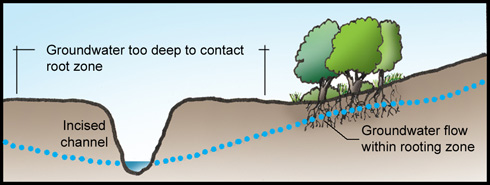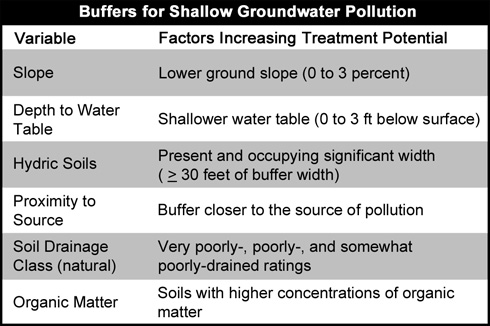GUIDELINES / 1.0 Water Quality
1.15 Buffers for Shallow Groundwater

Buffers may contact shallow groundwater and through various processes, remove some pollutants transported in it.
Nitrate: Removal rates can be > 75 percent
Dissolved phosphorus: Not effectively removed
Pesticides: Limited data at this time
Key Design Considerations
- Shallow groundwater is typically found near streams, lake shores, and wetlands. Buffers are effective where/when shallow groundwater flows toward the stream (and not vice versa).
- Where groundwater emerges as a spring or seep, it may flow across the buffer zone too quickly to be effectively treated. A wider buffer may be necessary to allow for reinfiltration.
- Buffers along deeply incised streams may not intercept groundwater. Groundwater may be shallower in locations farther away from these streams. These areas may be effective locations for buffers to filter groundwater.

Key Design Considerations (continued)
- Most nitrate reduction in shallow groundwater occurs within 30 to 100 feet of entering a buffer.
- The greatest nitrate removal occurs on sites where groundwater flow is confined within the root zone (shallower than about 3 ft) by a dense soil layer (aquitard) or bedrock.
- Select plants with adequate rooting depth to intercept the groundwater flow.
- Select plants tolerant of seasonal water table fluctuations and with higher root biomass.
- Because natural groundwater flow patterns can be very complex, consult with appropriate professionals.
- In areas where groundwater drainage has been augmented with drain tile pipes or ditches, groundwater flow will often bypass buffers untreated. Placing constructed wetlands at the end of tile drains or ditches can help reduce this problem.

 DOWNLOAD: 1.15 Guidelines and References (PDF)
DOWNLOAD: 1.15 Guidelines and References (PDF)
